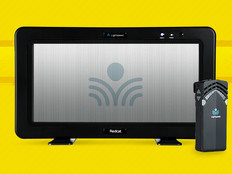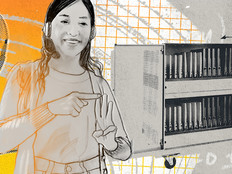Podcasting at School
Districts turn to push technology to engage parents, community and kids.

It’s notoriously difficult for parents and community members to stay abreast of school happenings. It’s equally difficult to engage tech-savvy students accustomed to the rapid crossfire of the digital world. A few districts are addressing both challenges by deploying push technology such as RSS (really simple syndication) feeds and podcasts.
Push technology is a technical and financial featherweight. “There are relatively few barriers to entry,” confirms Barry Dodson, virtual campus principal for Carrollton-Farmers Branch (Texas) Independent School District. Unlike earlier applications such as PowerPoint and Web development that required some level of programming knowledge, podcasting is a straightforward application appropriate for both the technophobe and the tech-savant. Current educational computers often ship with preinstalled podcast creation software. Most additional required software is free and infrastructure requirements are minimal. In fact, districts need not invest in portable digital music players to enter the podcasting arena, says John Hendron, Webmaster for Goochland County (Va.) Public Schools.
Other misconceptions exist as well. Push technology is a bit of an oxymoron, says Thomas Algarin, director of communications for Marietta (Ga.) City Schools. “It’s more like pull because people can subscribe to information of interest where and when they want it.”
Marietta launched its push technology program in January 2007 and is focused on connecting with parents and community members. Parents can subscribe to the district’s weekly e-newsletter, @home, news releases or special-events feeds. “It’s one more way for the district to share its message,” explains Algarin.
RSS also bypasses e-mail limits on attachments or links, and information is instantaneously available to subscribers. RSS appeases the bandwidth-conscious, too, as feeds consist of text files that don’t consume much bandwidth. Districts can acquire free RSS creation applications, so the only real cost associated with RSS is staff time.
Marietta plans to grow its fledgling RSS program. Algarin hopes to graduate to podcasts and expand the program to classrooms, enabling teachers to podcast lectures or share daily concepts with parents.
RSS 101
Implementing RSS is a fairly simple technical project, says Marietta (Ga.) City Schools Webmaster Chance Bush. He and Communications Director Thomas Algarin outline the process.
- The key ingredient is relevant, current content. IT, communications and administrators should collaborate to identify relevant information.
- Select a news-feed creation application to write XML (eXtensible Markup Language) code. The industrious can write code by hand.
- Inform parents and community members about the RSS option. Users will need to download a free RSS newsreader such as NewsGator, GoogleReader or Attensa. “This does require a certain comfort level with technology,” notes Algarin. Marietta provides subscription directions to help interested readers enter the RSS world.
- Keep on top of your content. Subscribers will disengage if the district sends feeds with outdated information such as an event that occurred months ago.
The Proof Is in the Podcast
 Other districts are turning straight to podcasts, which add audio and video to the mix. Carrollton-Farmers Branch launched a podcast pilot last year with English as a Second Language students. Prior to the pilot, these students retained about half of their weekly vocabulary. But after teachers equipped kids with iPods and recorded vocabulary podcasts, retention soared to more than 90 percent, says Dodson.
Other districts are turning straight to podcasts, which add audio and video to the mix. Carrollton-Farmers Branch launched a podcast pilot last year with English as a Second Language students. Prior to the pilot, these students retained about half of their weekly vocabulary. But after teachers equipped kids with iPods and recorded vocabulary podcasts, retention soared to more than 90 percent, says Dodson.
After its first taste of academic success, the district leapt into push technology with both feet, investing in 1,200 iPods for teachers and building principals. Educators were up and running after basic training and have created 2,500 podcasts this school year. A middle school history teacher incorporates folk songs into podcasts; others engage kids in the podcast-creation process. Some teachers post pre-test reviews for kids and parents, others create movies to promote academic or enrichment activities and a number of administrators share messages via podcasts.
One Goochland County principal bridges the parent and student gap by collaborating with a student on a monthly podcast. The two analyze and broadcast school events from the administrative and student points of view. An art teacher uses podcasts for maximum impact. She photographs students’ work and dictates the standards and objectives it shows to create a multimedia video podcast. “It’s a great way to share objectives and promote art in school,” says Hendron.
Podcasting possibilities are infinite and the technology speaks kids’ language. “This is the way kids consume and create information,” says Dodson. “Podcasting is a great alternate to the traditional eight-page report,” points out David Warlick of The Education Podcast Network. Like RSS feeds, podcasting is easy on the budget.
Goochland County Public Schools launched a fairly ambitious podcasting initiative in 2006, primarily relying on legacy technology. “You don’t need an iPod to create podcasts; it’s a luxury that provides portability for recording,” affirms Hendron. Goochland teachers use free audio-editing software to create podcasts on their notebook PCs. Students side-step the portability issue by using voice recorders or a USB microphone to produce audio podcasts; digital video cameras suffice for video podcasting.
High Voltage Content
Not all podcasts are created equally. Some will engage kids and communities. Others could put them to sleep. The talking head model is a no-no, says Dodson.
The best way for podcast newbies — students, teachers or administrators — to learn about the medium is to view and listen to podcasts. “This helps them figure out the structure,” says Hendron. Learners will quickly realize that combined stimuli — voice, video, photos, PowerPoint slides — pack a punch. Hendron also encourages teachers to branch out on their own and find non-educational podcasts that interest them. Teachers are likely to find some out-of-the-box creations that will spur new ways of creating and using podcasts. Carrollton-Farmers Branch tries to place as few restrictions on teacher podcasting as possible. “It’s about innovation,” notes Dodson. Nevertheless, the principal admits students prefer brief, specific podcasts. Five-minute, multimedia podcasts are more popular than 60- to 90-minute lectures.
With kids, Warlick says it’s best to teach them how to use the technology and then get out of their way. “The best applications use technology to give voice to student learning, transforming the student into a teacher/storyteller,” he says. Teachers can motivate students to produce high-quality content by selecting only a few podcasts for publication.
Still, not every podcast needs to be Emmy-worthy. Podcasts can be used to duplicate other content. Minneapolis Public Schools, for example, podcasts school board minutes. And some teachers transform PowerPoint presentations into podcasts for test preparation.
The Fine Print
Districts eyeing podcast potential need to go into the program with both eyes open. Podcasting, which graduates from text to audio and video, can burden the network or server. Carrollton-Farmers Branch purchased a separate server that includes internal software to post and organize podcasts to house its podcasts. Goochland relies on its dedicated blogging server. The 100-gigagbyte server suffices for the 200-teacher district; it currently holds more than 250 podcasts. The district plans to develop a plan for the future. “We need to decide if we wipe it clean every school year or allow it to keep growing,” says Hendron. Purging the server is more economical, but teachers may want to maintain some podcasts for samples or future reference.
“Districts do need a pretty big pipe to handle podcasting,” says Hendron. A digital signal (DS3) line suffices for podcast traffic in Goochland. Carrollton runs into the occasional server crash during high-traffic times — when scores of teachers attempt to upload podcasts, for example; the district is working to address the problem. One exception to the “big pipe” rule is the district that aims to keep content in-house for internal staff and student consumption. In this case, a 100BaseT (Ethernet) connection should suffice, as outsiders won’t pull content.
One potential solution for districts with an underpowered network might be a dedicated wide area network with load-balancing to prioritize traffic, says Chance Bush, Marietta City Schools Webmaster. Another option for districts limited by T1 lines is a hosting service, where an outside provider (and network) houses the podcast library. In fact, Warlick recommends that districts contract with a podcast hosting service regardless of the network capacity. That’s because any podcast could become wildly popular. If the right blogger promotes a podcast it could translate into 100,000 downloads a week, enough to shut down all but the most robust school networks, says Warlick.
A Web-hosting service offers other advantages of outsourcing. Hosted services remove the burden from district IT staff, and many provide templates or wizards that allow teachers to create podcasts with a few mouse clicks. Other benefits include end-to-end management, publishing, security and guarantee immediate reliable delivery of content. Typical Web servers aren’t equipped to handle multiple simultaneous downloads of podcasts. Think 250 subscribers syncing iPods at 8 a.m. The simultaneous pulling of 250 30Mbps podcasts strains the network and could lead to denial of service. Hosting services are also scalable and secure; they can limit the audience to only students, parents and teachers if desired.
Despite a few potential technical roadblocks, push technology represents a winning combination for school districts. It’s a relatively easy-to-deploy, high-tech solution that engages kids and community without breaking the bank.
Podcasting by the Numbers
- Average podcast size: less than one megabyte to more than 150 megabytes depending on length and type of content
- Logitech 250 headphones with built-in microphone: $29.99
- MP3 player: prices vary depending on model, but start at $44.99
- Podshow Creator podcast hosting services range from $9.95/month for 250 megabytes of storage to $39.95/month for 1 gigabyte of storage; security features cost another $4.95/month
- Total podcast project cost in Carrollton-Farmers Branch: $500,000 (server, iPods and headphones) o Monthly podcast hosting costs for one teacher: as little as $5
Source: Jerry Gorman, CEO of Podshow Creator






